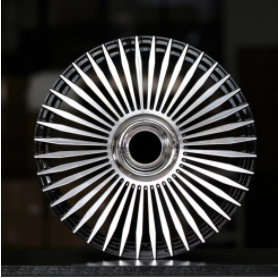
custom monoblock wheels
A metal bar how to become a wheel, the process is very complex, take a look at the manufacturing process of the wheel
A wheel hub, also known as a rim, is a barrel-shaped part of a tire that is centered on an axle to support the tire.
Common automotive wheels include steel wheels and aluminum wheels.
Steel wheels have high strength and are often used for large vehicles; however, steel wheels are heavy and have a single shape, which does not meet the concept of low-carbon and fashion nowadays, and are gradually being replaced by aluminum alloy wheels.
At present, the original wheels of passenger cars in the market are basically aluminum alloy wheels.
Wheel spin forging process.
Shown here is the spin forging process, a relatively high-end forming process, and the products are mainly supplied to the domestic and foreign bus, truck and high-end car markets.
The advantage is the good inherent quality of the product, product strength, high quality and light; disadvantage is the high cost of equipment, traditional forging process manufacturing products can only be completed by milling processing, low metal utilization and production efficiency is not high.
Forging is divided into traditional forging and lap forging, lap forging can directly forge the shape of the wheel spokes.
Casting wheel technology is relatively simple, suitable for mass production and low cost
Casting is the most common process for producing aluminum wheels, and it is also more economical, more common are gravity casting and low-pressure casting.
Gravity forging is to cast the molten metal in a mold to shape and harden, and then the finished product is obtained after the cooled blank is precision machined and polished and painted by a lathe.
Low-pressure casting is a relatively advanced casting process, using vacuum suction to suck the melted metal into the mold, which is conducive to temperature control and the exclusion of impurities, there will be no porosity in the casting and uniform density, and the strength is higher compared to low-pressure casting.
But no matter which casting, the technical process is relatively simple and suitable for mass production and beneficial to reduce costs.
● Forged wheel technology is complex, high cost but very good performance
Forging is the most advanced production method under the mass production of wheels.
A forged wheel is a piece of aluminum ingot repeatedly forged into a wheel blank by using a large forging press under a certain pressure in a heated state.
The effect of this process is to stretch the width of the rim to reach the corresponding specification.
After spinning, the wheel is basically shaped and then processed by machine tools, polished and painted to get the finished wheel.
Because of the complex forging technology and expensive forging equipment, the cost of buying some large forging presses is tens of millions of yuan, so the cost of forging wheels is relatively much higher.
The appearance is difficult to distinguish and the weight is different
The appearance of some cast wheels imitates the characteristics of forging, so it is difficult for ordinary consumers to distinguish between the two, but there is a big difference between the two in terms of metal characteristics.
But quality cast wheels are generally about 20% heavier than forged wheels.
We are professional in forged wheels for many years, you can find more forged wheels as below.


